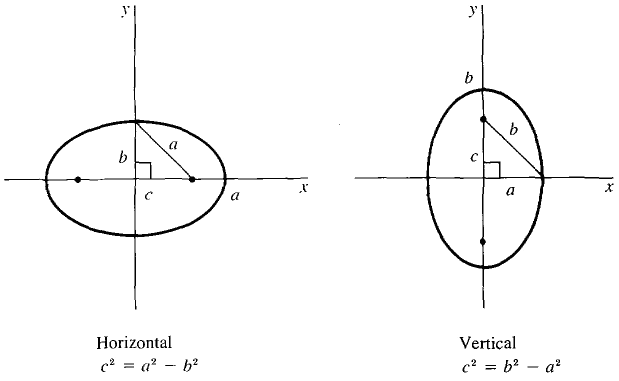| The ebook Elementary Calculus is based on material originally written by H.J. Keisler. For more information please read the copyright pages. |

|

Home  Limits, Analytic Geometry, and Approximations Limits, Analytic Geometry, and Approximations  Ellipses and Hyperbolas Ellipses and Hyperbolas  Theorem 1 Theorem 1 |
|






|
|
Theorem 1
THEOREM 1 For any positive a and b, the graph of the equation
is an ellipse with its center at the origin. There are three cases: (i) a = b. The ellipse is a circle of radius a. (ii) a > b. This is a horizontal ellipse, whose major axis is the x-axis, and whose minor axis is the y-axis. The length is 2a. The foci are at (-c, 0) and (c, 0), where c is found by c2 = a2 - b2. (iii) a < b. This is a vertical ellipse whose major axis is the y-axis and whose minor axis is the x-axis. The length is 2b. The foci are at (0, -c) and (0, c), where c is found by c2 = b2- a2.
Figure 5.5.2 This theorem is illustrated by Figure 5.5.2. Here is the proof in case (ii), a > b. A point P(x, y) is on the ellipse with foci (-c, 0), (c, 0) and length 2a if and only if the sum of the distances from P to the foci is 2a. That is,
Rewrite this as
Square both sides:
Simplify:
Square both sides again: a2(x2 + 2cx + c2 + y2) = a4 + 2a2cx + c2x2. Collect the x2 and y2 terms and simplify. x2(a2 - c2) + y2(a2) = a4 - a2c2 = a(a2 - c2). Using the equation b2 = a2 - c2, write this as x2b2 + y2a2 = a2b2. Finally, divide by a2b2 to obtain the required equation
|
|
Home  Limits, Analytic Geometry, and Approximations Limits, Analytic Geometry, and Approximations  Ellipses and Hyperbolas Ellipses and Hyperbolas  Theorem 1 Theorem 1 |
|
Last Update: 2006-11-05








